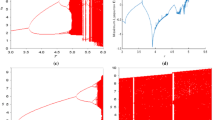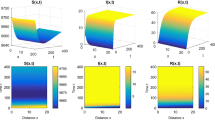Abstract
The dynamics of simple discrete-time epidemic models without disease-induced mortality are typically characterized by global transcritical bifurcation. We prove that in corresponding models with disease-induced mortality a tiny number of infectious individuals can drive an otherwise persistent population to extinction. Our model with disease-induced mortality supports multiple attractors. In addition, we use a Ricker recruitment function in an SIS model and obtained a three component discrete Hopf (Neimark–Sacker) cycle attractor coexisting with a fixed point attractor. The basin boundaries of the coexisting attractors are fractal in nature, and the example exhibits sensitive dependence of the long-term disease dynamics on initial conditions. Furthermore, we show that in contrast to corresponding models without disease-induced mortality, the disease-free state dynamics do not drive the disease dynamics.
Similar content being viewed by others
References
Allen L.J.S., Burgin A.M.: Comparison of deterministic and stochastic SIS and SIR models in discrete-time. Math. Biosci. 163, 1–33 (2000)
Allen L.J.S.: Some discrete-time SI, SIR and SIS epidemic models. Math. Biosci. 124, 83–105 (1994)
Alligood K., Sauer T., Yorke J.A.: Chaos: An Introduction to Dynamical Systems. Springer, New York (1996)
Anderson R.M., May R.M.: Infectious Diseases of Humans: Dynamics and Control. Oxford University Press, Oxford (1992)
Bailey N.T.J.: The Mathematical Theory of Infectious Diseases and its Applications. Griffin, London (1975)
Berezovsky F., Karev C., Song B., Castillo-Chavez C.: A simple model with surprising dynamics. Math. Biosci. Eng. 2, 133–152 (2005)
Berezovsky F., Novozhilov S., Karev G.: Population models with singular equilbrium. Math. Biosci. 208, 270–299 (2007)
Beverton R.J.H., Holt S.J.: On the Dynamics of Exploited Fish Populations. Fish. Invest. Ser. II, H. M. Stationery Office, London (1957)
Castillo-Chavez C., Yakubu A.: Dispersal, disease and life-history evolution. Math. Biosci. 173, 35–53 (2001)
Castillo-Chavez C., Yakubu A.: Discrete-time S-I-S models with complex dynamics. Nonlinear Anal. 47, 4753–4762 (2001)
Castillo-Chavez C., Yakubu A.A.: Intraspecific competition, dispersal and disease dynamics in discrete-time patchy environments. In: Castillo-Chavez, C., Blower, S., van den Driessche, P., Kirschner, D., Yakubu, A.-A. (eds) Mathematical Approaches for Emerging and Reemerging Infectious Diseases: An Introduction to Models, Methods and Theory, pp. 165–181. Springer, New York (2002)
Cull P.: Local and global stability for population models. Biol. Cybern. 54, 141–149 (1986)
Elaydi S.N., Yakubu A.-A.: Global stability of cycles: Lotka-Volterra competition model with stocking. J. Difference Equ. Appl. 8, 537–549 (2002)
Feng Z., Castillo-Chavez C., Capurro A.F.: A model for tuberculosis with exogenous reinfection. Theor. Pop. Biol. 57, 235–247 (2000)
Franke J.E., Yakubu A.-A.: Population models with periodic recruitment functions and survival rates. J. Difference Equ. Appl. 11, 1169–1184 (2005)
Franke J.E., Yakubu A.-A.: Discrete-Time SIS Epidemic Model In a Seasonal Environment. SIAM J. Appl. Math. 66(5), 1563–1587 (2006)
Hadeler K.P., Castillo-Chavez C.: A core group model for disease transmission. Math. Bisoci. 128, 41–55 (1995)
Hadeler K.P., van den Driessche P.: Backward bifurcation in epidemic control. Math. Biosci. 146, 15–35 (1997)
Hassell M.P., Lawton J.H., May R.M.: Patterns of dynamical behavior in single species populations. J. Animal Ecol. 45, 471–486 (1976)
Hsu S.-B., Hwang T.-W., Kuang Y.: Global analysis of the Michaelis-Menten type ratio-dependent predator-prey system. J. Math. Biol. 432, 489–506 (2001)
Hwang T.-W., Kuang Y.: Deterministic extinction effect in parasites on host populations. J. Math. Biol. 46, 17–30 (2003)
Kermack W.O., McKendrick A.G.: A contribution to the mathematical theory of epidemics. Proc. R. Soc. Lond. Ser. A 138, 55–83 (1932)
Kuang Y., Beretta E.: Global qualitative analysis of a ratio-dependent predator-prey system. J. Math. Biol. 36, 389–406 (1998)
May R.M., Oster G.F.: Bifurcations and dynamic complexity in simple ecological models. Am. Nat. 110, 573–579 (1976)
May R.M.: Simple mathematical models with very complicated dynamics. Nature 261, 459–469 (1977)
May R.M.: Stability and Complexity in Model Ecosystems. Princeton University Press, Princeton (1974)
Nicholson A.J.: Compensatory reactions of populations to stresses, and their evolutionary significance. Aust. J. Zool. 2, 1–65 (1954)
Ricker W.E.: Stock recruitment. J. Fish. Res. Board Canada II 5, 559–623 (1954)
Rios-Soto, K., Castillo-Chavez, C., Neubert, M., Titi, E., Yakubu, A.: Epidemic spread in populations at demographic equilibrium. Contemporary Mathematics, AMS volume 410, Mathematical Studies on Human Disease Dynamic: Emerging Paradigms and Challenges, pp. 297–309 (2006)
Ross R.: The Prevention of Malaria. Murray, London (1911)
Sacker R.S.: A new approach to the perturbation theory of invariant surfaces. Comm. Pure Appl. Math. 18, 717–732 (1965)
van den Driessche P., Watmough J.: A simple SIS epidemic model with a backward bifurcation. J. Math. Biol. 40, 525–540 (2000)
Yakubu A.-A.: Allee effects in a discrete-time SIS epidemic model with infected newborns. J. Difference Equ. Appl. 13, 341–356 (2007)
Yakubu A.-A., Fogarty M.: Spatially discrete metapopulation models with directional dispersal. Math. Biosci. 204, 68–101 (2006)
Author information
Authors and Affiliations
Corresponding author
Rights and permissions
About this article
Cite this article
Franke, J.E., Yakubu, AA. Disease-induced mortality in density-dependent discrete-time S-I-S epidemic models. J. Math. Biol. 57, 755–790 (2008). https://doi.org/10.1007/s00285-008-0188-9
Received:
Revised:
Published:
Issue Date:
DOI: https://doi.org/10.1007/s00285-008-0188-9




